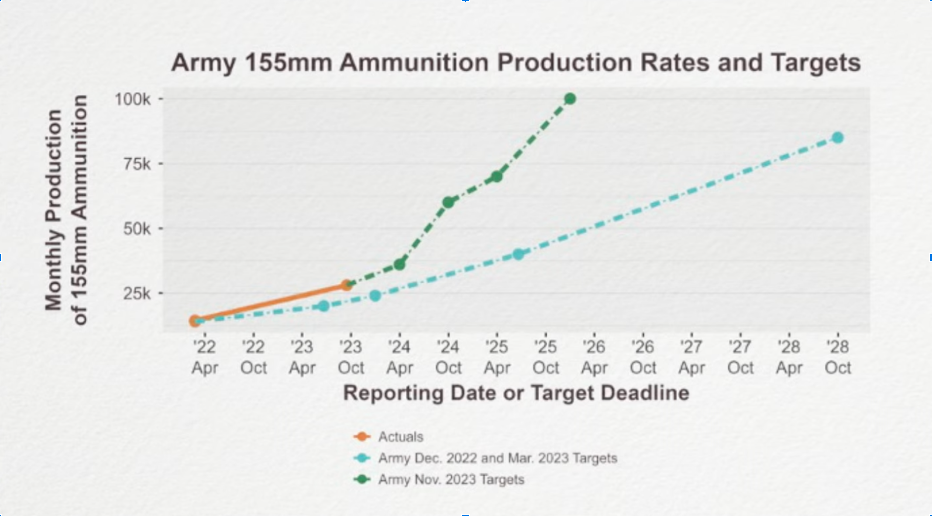Army aims to double 155mm shell production by October
The Army aims to double production of a key munition used in Ukraine by October, Army acquisition chief Doug Bush said today.
U.S. production of 155mm artillery shells is slated to rise from 28,000 last October—the most recent month for which hard numbers have been released—to roughly 37,000 in April and about 60,000 in October 2024, according to a slide shared at a CSIS think tank event.
The Army then hopes to rapidly increase production in 2025, from just under 75,000 shells that April to 100,000 in October, the slide also showed.

That planned increase is due in part to a new factory the Army is building in Texas, which will “have an entirely new way of making the shell, using entirely new tech we’ve never used before,” Bush said.
The Army has already sharply increased its production of 155mm shells since Russia’s full-scale invasion of Ukraine in February 2022, with monthly production rates rising from 14,000 past 28,000 by last October.
The Army originally planned a smaller increase, to 40,000 rounds per month by 2025, Army Secretary Christine Wormuth said in 2022.
The availability of ammunition, especially large artillery shells like 155mm, has kept Ukraine from matching Russia’s volume of fire. Currently, Ukrainian forces fire around 2,000 shells per day, about one-fifth the Russian output.
Both sides have rushed to secure more munitions, with Ukraine turning to the U.S., EU, and others, while Russia has acquired shells from North Korea and Iran. The U.S. has struggled to match Ukraine’s immense munitions needs while not running down its own supplies to dangerously low levels.
The massive use of the munitions like 155mm shells may trigger a rethinking of how much the U.S. needs in its own stockpiles, Bush said.
“If larger stockpiles are a way to mitigate risk for an extended conventional conflict, then that needs to be looked at,” he said.
With U.S. aid to Ukraine stalled amid congressional delays, Ukrainian forces have had to ration shells even as Russia presses an offensive in the eastern Ukrainian town of Avdiivka. At times, Ukrainian forces have been reduced to firing smoke shells rather than high-explosive shells at Russian forces.
The U.S. has not needed to increase production of smaller artillery shells, tank shells, or mortar rounds for Ukraine, as the U.S. has been able to meet Ukraine’s needs without significantly running down its own stockpiles, Bush said.
Investment in 155mm production, though, will help boost the U.S. ability to create other calibers of shells thanks to investments in explosives and metal fabrication, he added. Thanks to Ukraine-related investments, the U.S. will end up with a “much healthier” industrial base for all types of conventional munitions, Bush said.
Whether the U.S. can actually make the 100,000 shells per month depends on Congress overcoming political divisions.
The Army has so far proposed funding the production increase through the regular supplemental bills Congress has voted on to fund Ukraine. The Biden Administration has proposed that $3.1 billion of a much larger Ukraine aid bill be spent on munition production and modernization.
So far, Congress has made no move to approve that bill. On Sunday, House Republican Leader Mike Johnson refused to support a version of the Ukraine aid bill that would pair funding with investments in border security.
Republicans, including Johnson, have criticized the bill as lacking enough support for border security.





Comments are closed.